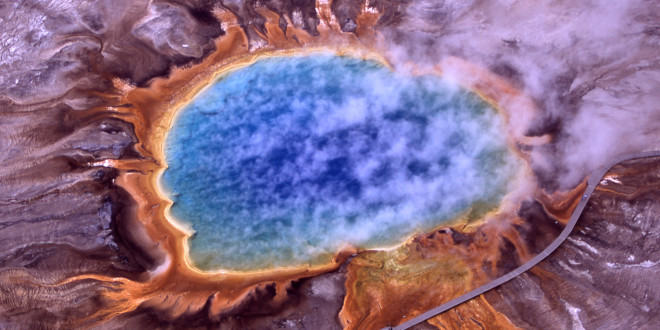New research into the Yellowstone National Park caldera posits a new and surprising theory for the source of Yellowstone’s geothermal power.
According to the Billings Gazette, geologists at the University of Illinois tracked seismic waves through the Greater Yellowstone Area, which make an “almost X-ray-like view” of subterranean conditions. Using this data, they ran scenarios on a supercomputer to determine how and why Yellowstone got its “hotspot.”
The team (comprising study leader/geology professor Lijun Liu and graduate students Jiashun Hu and Quan Zhou) concluded that Yellowstone’s heat comes from the Pacific Coast, which is “funneled” eastward.
You can read the team’s report, published in Nature, here.
The theory contradicts the currently held view that Yellowstone’s hotspot is fed by a “plume” of magma that could fill Arizona’s Grand Canyon 11.2 times over. Indeed, in a statement, Liu said his team’s findings “directly [challenge] the traditional view that most of the heat came from the plume below Yellowstone.”
According to the Gazette, researchers at the University of Utah, who spearheaded the plume theory, disagree with Liu et al.’s findings:
Similar seismic tomography research by the University of Utah, published in 2015 and which can be found on the Yellowstone Volcano Observatory’s website, came to a different conclusion. In that study scientists discovered one shallow magma reservoir under Yellowstone’s hotspot that is fed by a much deeper mantle plume.
“Mantle plume theory has its problems, but it makes more sense than any other theories, which is why it remains the accepted explanation for places like Hawaii and, yes, even Yellowstone,” said Michael Poland, the Yellowstone Volcano Observatory scientist-in-charge, in an email.
Poland added that Liu’s research is not “the final word on the story” and “is a work in progress.
“The chemistry is a major sticking point — the chemical signature of Yellowstone is very much reflective of a deep mantle source (a plume),” Poland said. “There are also other seismic tomography studies that do see a plume. So I think these researchers still have a way to go before they are able to demonstrate that their model satisfies more of the observations than other previously proposed models. It will be interesting to see how their research develops.”
Liu has previously contested the plume’s importance to Yellowstone’s geothermal dynamics, arguing that the slab of tectonic plate above the magma plume is preventing the plume’s heat from reaching the surface, much like the lid of a cooking pot. From the Gazette:
“The heat needed to drive volcanism usually occurs in areas where tectonic plates meet and one slab of crust slides, or subducts, under another,” Liu said. “However, Yellowstone and other volcanic areas of the inland western U.S. are far away from the active plate boundaries along the West Coast.”
Liu said his most recent research shows that the hot Pacific mantle “has been ‘pumped’ eastward toward Yellowstone since 16 (million years ago) through tears within the down-going oceanic plate … this hot horizontal mantle flow should be the force that formed the hotspot track leading toward Yellowstone today.”
Plume theory has been around since the early 1970s, according to the Gazette, and has been variously contradicted and upheld. Indeed, according to geology writer Sara Platt, some have called it a “zombie science,” alternately killed and revived with no seeming end in sight. Platt adds that plume theory, whatever its faults, has its merits and reflects the inherent difficulty of mapping Earth’s interior, which features conditions far beyond the ranges of human (or technological) survivability.
 Yellowstone Insider Your Complete Guide to America's First National Park
Yellowstone Insider Your Complete Guide to America's First National Park





